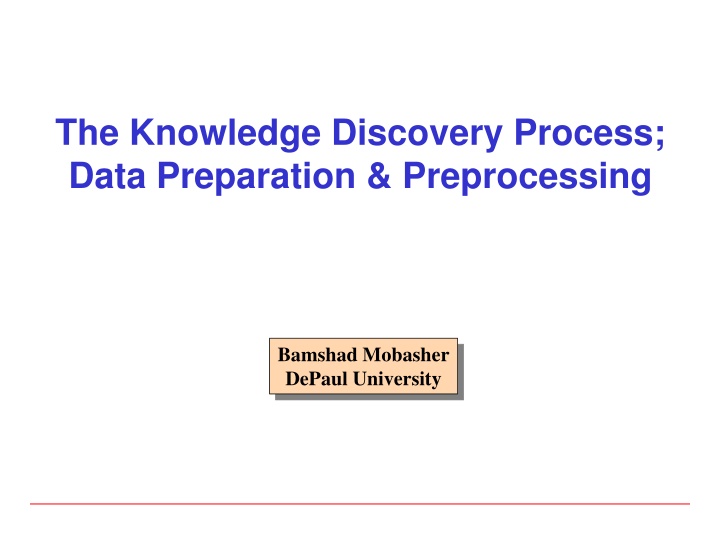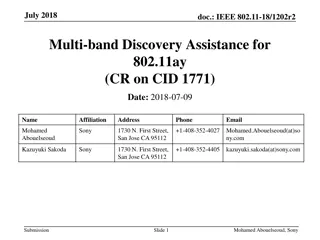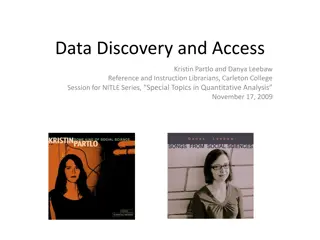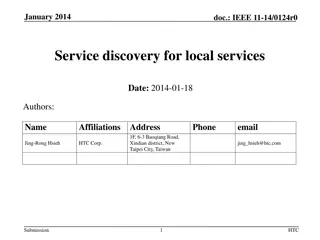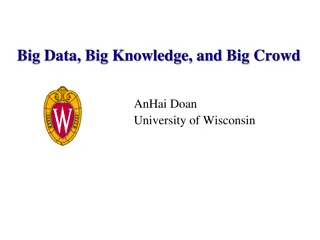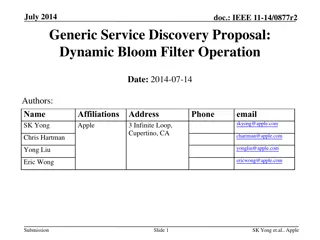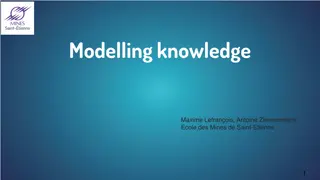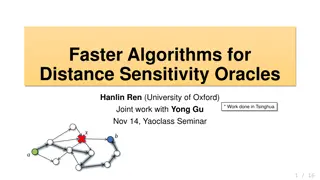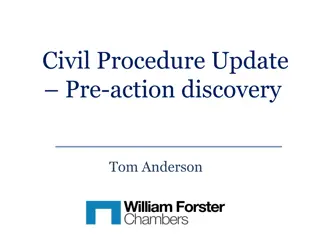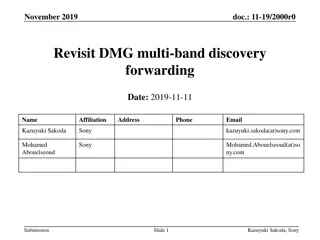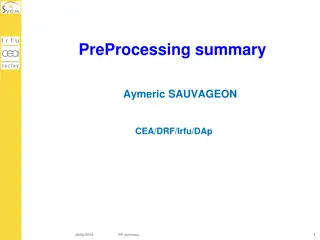Data Preprocessing: Enhancing Data Quality for Effective Knowledge Discovery
Data preprocessing is crucial for preparing raw data in real-world applications, ensuring consistency, completeness, and accuracy. It involves steps like data cleaning, dealing with missing values, and smoothing out noise to improve the quality of data for better decision-making and knowledge discovery.
Download Presentation

Please find below an Image/Link to download the presentation.
The content on the website is provided AS IS for your information and personal use only. It may not be sold, licensed, or shared on other websites without obtaining consent from the author.If you encounter any issues during the download, it is possible that the publisher has removed the file from their server.
You are allowed to download the files provided on this website for personal or commercial use, subject to the condition that they are used lawfully. All files are the property of their respective owners.
The content on the website is provided AS IS for your information and personal use only. It may not be sold, licensed, or shared on other websites without obtaining consent from the author.
E N D
Presentation Transcript
The Knowledge Discovery Process; Data Preparation & Preprocessing Bamshad Mobasher DePaul University
The Knowledge Discovery Process - The KDD Process 2
Data Preprocessing Why do we need to prepare the data? In real world applications data can be inconsistent, incomplete and/or noisy Data entry, data transmission, or data collection problems Discrepancy in naming conventions Duplicated records Incomplete or missing data Contradictions in data What happens when the data can not be trusted? Can the decision be trusted? Decision making is jeopardized Better chance to discover useful knowledge when data is clean 3
Data Preprocessing Data Cleaning Data Integration Data Transformation -2,32,100,59,48 -0.02,0.32,1.00,0.59,0.48 Data Reduction 4
Data Cleaning Real-world application data can be incomplete, noisy, and inconsistent No recorded values for some attributes Not considered at time of entry Random errors Irrelevant records or fields Data cleaning attempts to: Fill in missing values Smooth out noisy data Correct inconsistencies Remove irrelevant data 5
Dealing with Missing Values Solving the Missing Data Problem Ignore the record with missing values; Fill in the missing values manually; Use a global constant to fill in missing values (NULL, unknown, etc.); Use the attribute value mean to filling missing values of that attribute; Use the attribute mean for all samples belonging to the same class to fill in the missing values; Infer the most probable value to fill in the missing value may need to use methods such as Bayesian classification or decision trees to automatically infer missing attribute values 6
Smoothing Noisy Data The purpose of data smoothing is to eliminate noise and smooth out the data fluctuations. Ex: Original Data for price (after sorting): 4, 8, 15, 21, 21, 24, 25, 28, 34 Partition into equidepth bins Bin1: 4, 8, 15 Bin2: 21, 21, 24 Bin3: 25, 28, 34 Binning Min and Max values in each bin are identified (boundaries). Each value in a bin is replaced with the closest boundary value. Each value in a bin is replaced by the mean value of the bin. means Bin1: 9, 9, 9 Bin2: 22, 22, 22 Bin3: 29, 29, 29 boundaries Bin1: 4, 4, 15 Bin2: 21, 21, 24 Bin3: 25, 25, 34 7
Smoothing Noisy Data Other Methods Similar values are organized into groups (clusters). Values falling outside of clusters may be considered outliers and may be candidates for elimination. Clustering Fit data to a function. Linear regression finds the best line to fit two variables. Multiple regression can handle multiple variables. The values given by the function are used instead of the original values. Regression 8
Smoothing Noisy Data - Example Want to smooth Temperature by bin means with bins of size 3: 1. First sort the values of the attribute (keep track of the ID or key so that the transformed values can be replaced in the original table. Divide the data into bins of size 3 (or less in case of last bin). Convert the values in each bin to the mean value for that bin Put the resulting values into the original table 2. 3. 4. ID 1 2 3 4 5 6 7 8 9 10 11 12 13 14 Outlook sunny sunny overcast rain rain rain overcast sunny sunny rain sunny overcast overcast rain Temperature Humidity 85 80 83 70 68 65 58 72 69 71 75 73 81 75 Windy FALSE TRUE FALSE FALSE FALSE TRUE TRUE FALSE FALSE FALSE TRUE TRUE FALSE TRUE ID 7 6 5 9 4 10 8 12 11 14 2 13 3 1 Temperature 58 65 68 69 70 71 72 73 75 75 80 81 83 85 85 90 78 96 80 70 65 95 70 80 70 90 75 80 Bin1 Bin2 Bin3 Bin4 Bin5 9
Smoothing Noisy Data - Example ID 7 6 5 9 4 10 8 12 11 14 2 13 3 1 Temperature 58 65 68 69 70 71 72 73 75 75 80 81 83 85 ID 7 6 5 9 4 10 8 12 11 14 2 13 3 1 Temperature 64 64 64 70 70 70 73 73 73 79 79 79 84 84 Bin1 Bin1 Bin2 Bin2 Bin3 Bin3 Bin4 Bin4 Bin5 Bin5 Value of every record in each bin is changed to the mean value for that bin. If it is necessary to keep the value as an integer, then the mean values are rounded to the nearest integer. 10
Smoothing Noisy Data - Example The final table with the new values for the Temperature attribute. ID 1 2 3 4 5 6 7 8 9 10 11 12 13 14 Outlook sunny sunny overcast rain rain rain overcast sunny sunny rain sunny overcast overcast rain Temperature Humidity 84 79 84 70 64 64 64 73 70 70 73 73 79 79 Windy FALSE TRUE FALSE FALSE FALSE TRUE TRUE FALSE FALSE FALSE TRUE TRUE FALSE TRUE 85 90 78 96 80 70 65 95 70 80 70 90 75 80 11
Data Integration Data analysis may require a combination of data from multiple sources into a coherent data store Challenges in Data Integration: Schema integration: CID = C_number = Cust-id = cust# Semantic heterogeneity Data value conflicts (different representations or scales, etc.) Synchronization (especially important in Web usage mining) Redundant attributes (redundant if it can be derived from other attributes) -- may be able to identify redundancies via correlation analysis: Pr(A,B) / (Pr(A).Pr(B)) = 1: independent, > 1: positive correlation, < 1: negative correlation. Meta-data is often necessary for successful data integration 12
Data Transformation: Normalization Min-max normalization: linear transformation from v to v v = [(v - min)/(max - min)] x (newmax - newmin) + newmin Note that if the new range is [0..1], then this simplifies to v = [(v - min)/(max - min)] Ex: transform $30000 between [10000..45000] into [0..1] ==> [(30000 10000) / 35000] = 0.514 z-score normalization: normalization of v into v based on attribute value mean and standard deviation v = (v - Mean) / StandardDeviation Normalization by decimal scaling moves the decimal point of v by j positions such that j is the minimum number of positions moved so that absolute maximum value falls in [0..1]. v = v / 10j Ex: if v in [-56 .. 9976] and j=4 ==> v in [-0.0056 .. 0.9976] 13
Normalization: Example z-score normalization: v = (v - Mean) / Stdev Example: normalizing the Humidity attribute: Humidity 0.48 0.99 -0.23 1.60 -0.03 -1.05 -1.55 1.49 -1.05 -0.03 -1.05 0.99 -0.54 -0.03 Humidity 85 90 78 96 80 70 65 95 70 80 70 90 75 80 Mean = 80.3 Stdev = 9.84 14
Normalization: Example II Min-Max normalization on an employee database max distance for salary: 100000-19000 = 81000 max distance for age: 52-27 = 25 New min for age and salary = 0; new max for age and salary = 1 ID 1 2 3 4 5 Gender F M M F M Age 27 51 52 33 45 Salary 19,000 64,000 100,000 55,000 45,000 ID 1 2 3 4 5 Gender 1 0 0 1 0 Age 0.00 0.96 1.00 0.24 0.72 Salary 0.00 0.56 1.00 0.44 0.32 15
Data Transformation: Discretization 3 Types of attributes nominal - values from an unordered set (also categorical attributes) ordinal - values from an ordered set numeric/continuous - real numbers (but sometimes also integer values) Discretization is used to reduce the number of values for a given continuous attribute usually done by dividing the range of the attribute into intervals interval labels are then used to replace actual data values Some data mining algorithms only accept categorical attributes and cannot handle a range of continuous attribute value Discretization can also be used to generate concept hierarchies reduce the data by collecting and replacing low level concepts (e.g., numeric values for age ) by higher level concepts (e.g., young , middle aged , old ) 16
Discretization - Example Example: discretizing the Humidity attribute using 3 bins. Humidity High High Normal High High Normal Low High Normal High Normal High Normal High Humidity 85 90 78 96 80 70 65 95 70 80 70 90 75 80 Low = 60-69 Normal = 70-79 High = 80+ 17
Data Discretization Methods Binning Top-down split, unsupervised Histogram analysis Top-down split, unsupervised Clustering analysis Unsupervised, top-down split or bottom-up merge Decision-tree analysis Supervised, top-down split Correlation (e.g., 2) analysis Unsupervised, bottom-up merge 18
Simple Discretization: Binning Equal-width (distance) partitioning Divides the range into N intervals of equal size: uniform grid if A and B are the lowest and highest values of the attribute, the width of intervals will be: W = (B A)/N. The most straightforward, but outliers may dominate presentation Skewed data is not handled well Equal-depth (frequency) partitioning Divides the range into N intervals, each containing approximately same number of samples Good data scaling Managing categorical attributes can be tricky 19
Discretization by Classification & Correlation Analysis Classification (e.g., decision tree analysis) Supervised: Given class labels, e.g., cancerous vs. benign Using entropy to determine split point (discretization point) Top-down, recursive split Correlation analysis (e.g., Chi-merge: 2-based discretization) Supervised: use class information Bottom-up merge: merge the best neighboring intervals (those with similar distributions of classes, i.e., low 2 values) Merge performed recursively, until a predefined stopping condition 20
Converting Categorical Attributes to Numerical Attributes ID 1 2 3 4 5 6 7 8 9 10 11 12 13 14 Outlook sunny sunny overcast rain rain rain overcast sunny sunny rain sunny overcast overcast rain Temperature Humidity 85 80 83 70 68 65 58 72 69 71 75 73 81 75 Windy FALSE TRUE FALSE FALSE FALSE TRUE TRUE FALSE FALSE FALSE TRUE TRUE FALSE TRUE 85 90 78 96 80 70 65 95 70 80 70 90 75 80 Attributes: Outlook (overcast, rain, sunny) Temperature real Humidity real Windy (true, false) Standard Spreadsheet Format OutLook OutLook OutLook Temp Humidity Windy Windy overcast rain sunny 0 0 1 0 0 1 1 0 0 0 1 0 0 1 0 0 1 0 1 0 0 . . . . . . Create separate columns for each value of a categorical attribute (e.g., 3 values for the Outlook attribute and two values of the Windy attribute). There is no change to the numerical attributes. TRUE FALSE 0 1 0 0 0 1 1 . . 85 80 83 70 68 65 64 . . 85 90 78 96 80 70 65 . . 1 0 1 1 1 0 0 . . 21
Data Reduction Data is often too large; reducing data can improve performance Data reduction consists of reducing the representation of the data set while producing the same (or almost the same) results Data reduction includes: Data cube aggregation Dimensionality reduction Discretization Numerosity reduction Regression Histograms Clustering Sampling 22
Data Cube Aggregation Reduce the data to the concept level needed in the analysis Use the smallest (most detailed) level necessary to solve the problem Queries regarding aggregated information should be answered using data cube when possible 23
Dimensionality Reduction Curse of dimensionality When dimensionality increases, data becomes increasingly sparse Density and distance between points, which is critical to clustering, outlier analysis, becomes less meaningful The possible combinations of subspaces will grow exponentially Dimensionality reduction Avoid the curse of dimensionality Help eliminate irrelevant features and reduce noise Reduce time and space required in data mining Allow easier visualization Dimensionality reduction techniques Principal Component Analysis Attribute subset selection Attribute or feature generation 24
Principal Component Analysis (PCA) Find a projection that captures the largest amount of variation in data The original data are projected onto a much smaller space, resulting in dimensionality reduction Done by finding the eigenvectors of the covariance matrix, and these eigenvectors define the new space x2 e x1 25
Principal Component Analysis (Steps) Given N data vectors (rows in a table) from n dimensions (attributes), find k n orthogonal vectors (principal components) that can be best used to represent data Normalize input data: Each attribute falls within the same range Compute k orthonormal (unit) vectors, i.e., principal components Each input data (vector) is a linear combination of the k principal component vectors The principal components are sorted in order of decreasing significance or strength The size of the data can be reduced by eliminating the weak components, i.e., those with low variance Using the strongest principal components, it is possible to reconstruct a good approximation of the original data Works for numeric data only 26
Attribute Subset Selection Another way to reduce dimensionality of data Redundant attributes Duplicate much or all of the information contained in one or more other attributes E.g., purchase price of a product and the amount of sales tax paid Irrelevant attributes Contain no information that is useful for the data mining task at hand E.g., students' ID is often irrelevant to the task of predicting students' GPA 27
Heuristic Search in Attribute Selection There are 2d possible attribute combinations of d attributes Typical heuristic attribute selection methods: Best single attribute under the attribute independence assumption: choose by significance tests Best step-wise feature selection: The best single-attribute is picked first. Then next best attribute condition to the first, ... {}{A1}{A1, A3}{A1, A3, A5} Step-wise attribute elimination: Repeatedly eliminate the worst attribute: {A1, A2, A3, A4, A5}{A1, A3, A4, A5} {A1, A3, A5}, . Combined attribute selection and elimination Decision Tree Induction 28
Decision Tree Induction Use information theoretic techniques to select the most informative attributes 29
Attribute Creation (Feature Generation) Create new attributes (features) that can capture the important information in a data set more effectively than the original ones Three general methodologies Attribute extraction Domain-specific Mapping data to new space (see: data reduction) E.g., Fourier transformation, wavelet transformation, etc. Attribute construction Combining features Data discretization 30
Data Reduction: Numerosity Reduction Reduce data volume by choosing alternative, smaller forms of data representation Parametric methods (e.g., regression) Assume the data fits some model, estimate model parameters, store only the parameters, and discard the data (except possible outliers) Ex.: Log-linear models obtain value at a point in m-D space as the product on appropriate marginal subspaces Non-parametric methods Do not assume models Major families: histograms, clustering, sampling, 31
Regression Analysis y Collection of techniques for the modeling and analysis of numerical data consisting of values of a dependent variable (also response variable or measurement) and of one or more independent variables (aka. explanatory variables or predictors) The parameters are estimated to obtains a "best fit" of the data Typically the best fit is evaluated by using the least squares method, but other criteria have also been used Y1 Y1 y = x + 1 x X1 Used for prediction (including forecasting of time-series data), inference, hypothesis testing, and modeling of causal relationships 32
Regression Analysis Linear regression: Y = w X + b Two regression coefficients, w and b, specify the line and are to be estimated by using the data at hand Using the least squares criterion on known values of Y1, Y2, , X1, X2, . Multiple regression: Y = b0 + b1 X1 + b2 X2 Many nonlinear functions can be transformed into the above Log-linear models Approximate discrete multidimensional probability distributions Estimate the probability of each point in a multi-dimensional space for a set of discretized attributes, based on a smaller subset of dimensions Useful for dimensionality reduction and data smoothing 33
Numerocity Reduction Reduction via histograms: Divide data into buckets and store representation of buckets (sum, count, etc.) Reduction via clustering Partition data into clusters based on closeness in space Retain representatives of clusters (centroids) and outliers Reduction via sampling Will the patterns in the sample represent the patterns in the data? Random sampling can produce poor results Stratified sample (stratum = group based on attribute value) 34
Sampling Techniques Raw Data Cluster/Stratified Sample Raw Data 35
